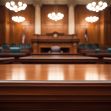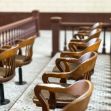Just after a man was indicted for murder, he gave a jailhouse interview to a reporter from The Bakersfield Californian, a local paper. In California, journalists are protected by the Shield Law, a part of the State constitution that says the media will not be held in contempt for failing to provide “unpublished” information learned during interviews. However, murder defendants also have their own constitutional rights. Legal precedent has established that State’s Shield Law “must yield to a criminal defendant’s right to a fair trial.”
The Bakersfield Californian v. The Superior Court of Kern County, and Robert Pernell Roberts illustrates how California courts balance these two constitutional rights. At the time of the interview, Roberts was awaiting trial for the murder of Benny Alcala, Jr., 43, whose body was found with two bullet holes near the electric vehicle charging station in a shopping mall near Bakersfield. On August 22, 2022, video surveillance showed two men walking toward the charging station where Alcala was located. Four days later, a “tipster” contacted the Bakersfield police with information about the murder. He said he had received a phone call and a text message with a confession that said, “I just killed somebody.”
Further investigation led police to Roberts, who was on “postrelease (sic) community supervision (PRCS)” at the time of the shooting. The number from which the phone call was made matched the one his PRCS supervisor had for him. Both Roberts and his co-defendant, Sebastian Parra, were then taken into custody and questioned about the shooting of Alcala.
During his questioning, Parra, who was homeless, stated that he could “possibly” tell them who did the shooting since he had met Roberts for the first time that night. After additional questioning and police comments that he should “tell the truth and not go down for this,” Parra said that Roberts “wanted to rob” the murder victim, who he thought would have money since he drove an electric car. After identifying Roberts from a photographic lineup, Parra was released from custody.
At a preliminary hearing where Parra was a witness, Roberts was charged with first-degree murder, second-degree robbery, and unlawful possession of a firearm on September 1. Parra’s testimony had several inconsistencies with those made during his police interview. These led to Robert’s attorney’s accusations that it was Parra, not Roberts, who was the actual shooter. After further investigation, much of it concerning the ownership of the 9mm firearm used in the shooting, Parra was also charged with first-degree murder and attempted robbery.
The Bakersfield Californian covered the story with the headline, “Prosecution’s key witness indicted, arrested in death of .” On February 23, the newspaper published another story, which led to the shield law v fair trial conflict that is the subject of the subpoena for the reporter’s jailhouse interview notes. The article contained many quotes from Parra, who repeatedly stated his astonishment about being indicted for Alcala’s murder. A subpoena for the reporter’s notes and any audio and video recordings obtained during the interview was issued to the Bakersfield Californian in March 2023.
The newspaper quickly filed a motion to quash the subpoena. The reporter denied having any audio or video recordings and stated that her notes were “unpublished, confidential journalistic work product.” Robert’s attorney opposed the newspaper’s motion to quash. A hearing to settle the matter was held on April 4. It focused on whether Roberts could “make a threshold showing that there is a reasonable possibility the information sought will materially assist with the defense.”
After a series of motions and opposing motions that went on until July, Kern County Superior Court Judge Elizabet Rodriguez ordered release of the reporter’s notes. Later, Kern County Superior Court Judge Tiffany Organ-Bowles also held the Bakersfield Californian in contempt. On November 17, Justice Rosendo Peña Jr. of the Fifth District Court of Appeal issued a published, unanimous opinion that rejected the ruling that the subpoena should be blocked but invalidated the contempt finding. Peña began his opinion by clarifying that while disobedience of a lawful court order is punishable as civil contempt, the Shield Law provides immunity. When she issued the contempt order, Organ-Bowles failed to show cause or specify the penalty she would impose.
But the crux of the case held that the Shield Law, which entitles a reporter to immunity from contempt, protects a reporter’s notes and other newsgathering materials but must yield if a “defendant seeking discovery makes the showing required to overcome it.” Citing the 1990 California Supreme Court case Delany v. Superior Court, Peña explained: “that a newsperson’s protection under the shield law must yield to a criminal defendant’s constitutional right to a fair trial when the newsperson’s refusal to disclose information would unduly infringe on the right.”
The lower court’s compliance with this standard was then reviewed under an “abuse of discretion standard.” Peña said that the matter could be settled with an “in-camera review” of the reporter’s notes, which “can resolve the problem of having to guess what the unpublished information may or may not reveal.” He then gave an overview of several pertinent cases that showed whether Roberts met his burden of meeting the standard set in Delaney.”
After reviewing the reporter’s explanation of what her notes contained, he concluded, “The superior court was within its discretion to conclude it is reasonably possible the reporters’ notes reflect unpublished statements by Parra that could materially assist Roberts at trial.” They could show the conflict between his statements to the court and those he made to the reporter. They could also impeach or add new material to Parra’s contentions.
He wrote that “The Newspaper’s arguments concerning Roberts’s threshold burden either misstate or misconstrue the case law.” He said that the superior court’s ruling was not an abuse of discretion. “Insofar as reasonable minds could differ on where the dividing line between “reasonable possibility” and “mere speculation” should be drawn under these facts, it only shows the determination was valid.” In addition, an in-camera review of the reporter’s material should have been conducted so that it could have “resolve(d) the matter expeditiously and short of a contempt adjudication.”






